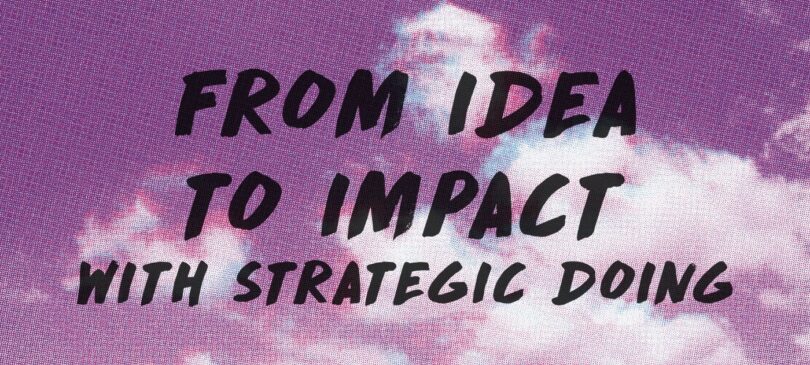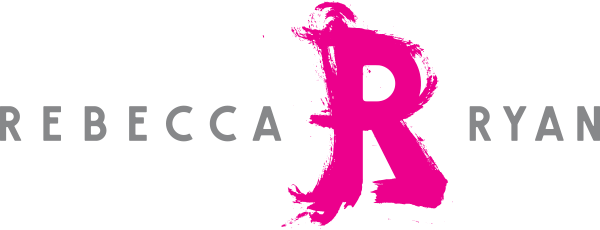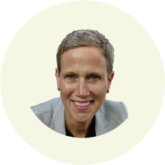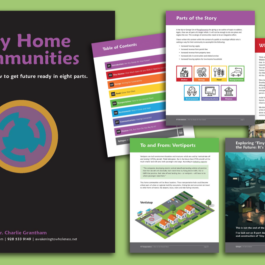What are the top 10 trends for the next ten years? Download the report here.

Strategic Doing is an action-oriented approach to strategy that comes out of Purdue University. It is a proven approach that builds on pre-existing strengths and assets, cultivates great ideas, and focuses the entire team on ideas that have minimum startup costs and maximum impact.
Step by step, it helps you form collaborations quickly, move them toward measurable outcomes and make adjustments along the way. You can use this approach to start right now, with the people in your workgroup or network, to launch a conversation and find and develop products and services that create brighter futures.
As a futurist, for example, I find this approach useful to help people take the conclusions from their strategic foresight work — where you look into the future to figure out what’s coming, so we can be ready — and translate them into concrete aligned actions and projects that help them get started today, in actually building their preferred futures. But you can use it too without a strategic foresight process.
Below I’ll go over key concepts of Strategic Doing. When you use this approach online or in person, you technically walk through a set of 10 rules. Along the way, these are the big ideas that you and your gang of collaborators implement:
1. Leverage the domino effect
Fun fact, Stephen Morris is a University of Toronto professor and he has demonstrated that dominoes can actually knock down things about 1.5 times their size. Starting from a domino just 5 mm tall, it would take 29 progressively-larger dominoes to wipe out the Empire State Building. Whoa.
With Strategic Doing, you are essentially doing the same thing in order to hit your big goal. You develop and execute a series of domino pieces (projects) that progressively get larger and build momentum because of increasing practical experience, relationships of trust, accomplishments, collaborators, and resources. With your first Strategic Doing workshop, you establish the first piece in the series. After you have implemented your first project, you can use Strategic Doing again and again to identify and design and execute your next domino pieces.
2. Break the strategy process down
As you walk through the 10 rules of Strategic Doing, they help you work through a sequence of four overarching questions:
- What could we do? Given a particular strategic outcome we’d like to achieve, what is the set of possible activities that might move us in that direction?
- What should we do? Out of all those activities, which one(s) make the most sense for us to pursue right now?
- What will we do? What concrete, short-term steps can those of us gathered together here take to move toward the outcome?
- What’s our 30/30? When will we come back together to report what we’ve learned, adjust as necessary, and set our course for the next period of time (usually, 30 days)?
Why these four questions? Functionally they help you break down these two strategy questions: Where are we going and how will we get there? Answering these questions gets a lot easier when you break them down like this.
3. Guide the conversation using appreciative inquiry
Before you dive into the first of the four overarching questions (What could we do?), your team must establish its starting point — a special kind of question to guide or frame your conversation. This step is critical in Strategic Doing; it affects the rest of the process.
Specifically you’ll develop an appreciative question about the topic or issue you’re interested in tackling. That means, instead of a problem- or deficit-focused question (e.g., What can we do to fix XYZ, Why is ABC not working), your framing question must have a positive, asset-based focus and use words like “Imagine” or “What if?” and “What would that look like?”
For example, in Omaha, Nebraska, one of the teams in a Strategic Doing workshop asked, What would our region be like if we truly cared for all people? You can feel how big that kind of a question is. It’s much different than a question of “What can we do to hang onto young talent?” which feels like a totally different tenor.
An appreciative question has a more expansive effect — allowing us to think without limits or constraints, firing the imagination. This is the kind of question that can help you and your team brainstorm and discover how you can create shared value together.
There is a time and place for problem- or deficit-focused questions. They inspire asking “Why” and digging into the root causes of an issue. Their place is not inside a Strategic Doing workshop, however. Instead, you might develop a memo on the problem and root causes as background information for your participants. It may help improve the relevance or tailoring of brainstormed solutions.
Getting your guiding question “right” typically takes some back and forth. Right, meaning it needs to be appreciative and excite as many of your collaborators as possible. It is best if you develop it before conducting a Strategic Doing workshop.
Thinking about your own issue or concern, what might be a really inspiring framing question?
4. Link and leverage existing assets
Want to create change without having to wait for permission or extra money? Existing assets are your friend. In Strategic Doing, every member of your team lists assets that meet all of these conditions:
- (s)he already “owns” or has certain access to it,
- (s)he is willing to share it with this Strategic Doing team, and
- It helps answer the framing question.
Developing this inventory may take multiple rounds. Assets include physical ones such as a meeting room, access to a playground, or simply your living room; skills and knowledge such as coding, graphic design, writing, or data analysis; social or network assets such as being a member of a relevant association or informal network or having enough influence to pull together certain groups of people; and capital that might be used to buy things that a group needs such as discretionary funding, administrative assistance, pro bono legal assistance or accounting.
Once you have such an inventory of assets, you can play “connect the dots.” This is the linking and leveraging part. Your team brainstorms ideas that connect two or more assets and help answer your framing question. This way you’re answering the first of the four overarching questions (What could we do?).
What assets do you have that might help you answer your framing question? Who might be the do-gooders that you could convene for a workshop and what might be some of their assets that they’re willing to share?
5. Choose the Big Easy
After brainstorming a range of options that help answer your framing question, your team selects one of them to flesh out in more detail. Which one do you choose? The Big Easy. It’s the option that your team thinks has the highest impact and is the easiest to accomplish. Executing it will help you build the experience, accomplishments, connections and support that your team needs to move toward a bigger goal. After all, most people prefer to join and support successful teams.
Once you’ve selected your Big Easy, your team proceeds to translate it into what’s called a “pathfinder project.” That is, you create a short written plan that defines what success looks like, develop measurable outcomes so you know whether you’re succeeding, and spell out a schedule of things to get done.
6. Think-Do-Think-Do
If Strategic Doing were a culinary dish, then “iterative learning and implementation” would be the awkwardly named secret sauce.
Why? It’s the principle that allows your team to adjust along the way and make sure your proposed project and approach continue to make sense in light of what you’re learning along the way.
It’s also the principle that enables you to build trust among your collaborators, who may not necessarily be working in the same department or even organization as you do. Working together with members of your network, as opposed to office colleagues, means there is no hierarchy or command structure to leverage so everyone does their part.
Instead, Strategic Doing helps your team build accountability for your actions and your peers through regular, structured meetings. Teams meet every 30 days (or 14 or 7 days) and each time every team member volunteers to get something specific, concrete done in time for the next meeting. Those assignments are documented and the results are discussed at the next meeting. If something didn’t get done, your team discusses how it will get done for next time (if it still makes sense to get done). And if you’re not in an action plan, if you don’t sign up for an action plan, you stop getting invited. Changing a community, changing a company, changing an organization is not a spectator sport. It is a sport where we all have to get involved and share and be a part of it.
How would YOU use Strategic Doing?
Can you see how this approach could help you create brighter futures? I’ll close by coming back to the Omaha example, where the framing question was What would our region be like if we truly cared for all people? One of the teams included the new president of a local college, a person running the foundation and HR for a local family business, and another resident who shared that there is only one domestic abuse shelter in the city that will take women and their children. (Many of the domestic abuse shelters can only take the mothers because the shelters do not have the license to provide childcare.) Most of the women are there for at least six weeks, usually eight weeks, and the shelter offers ongoing childcare.
Using the Strategic Doing process, the college president shared that one of their assets is their Certified Nursing Assistant (CNA) training program, which is six weeks long. The foundation person shared that their organization supports efforts to help people get upskilled. By the end of the meeting, the team decided to fund and implement a six-week CNA program at this domestic violence shelter. Now women with children who leave their abuser can move into this shelter and come out with improved skills and job prospects while keeping their little family intact.
People can absolutely be creative. All they need is a structure for how to talk about assets and what they can bring in a way that is a bit more generative and appreciative. Strategic Doing offers that structure as a lean, agile and fast approach for developing and creating brighter futures.
Strategic doing webinar:
If you enjoyed this post, please subscribe to our newsletter.

Yasemin Arikan
Yasemin (Yas) Arikan operates the research vessel. She is a futurist who uses foresight and social science methods to help clients understand how the future could be different from today and then use these insights to inform strategy and vision. Her work includes developing scenarios on the futures of public health, health care, society and technology for associations, foundations, government, and business. Bonus: Yas can help you take your gift wrapping game to the next level. And she can talk with you about it in English, German, or Turkish. Watch Yas' Q&A on how NGC helps organizations prepare for the future using Strategic Foresight.
Yasemin Arikan Promoted to Director of Futures Research
NEXT Generation Consulting (NGC) announced the promotion of Yasemin Arikan to Director of Futures Research. Arikan will lead the company’s efforts to...
Is Your Housing Market Ready for Your Future?
One of the biggest problems facing many cities and towns is inadequate housing. This problem is most acute for seniors, veterans with disabilities, and low-income groups ...
Three Things Martha Stewart Gets Right About Return to Office (RTO)
The original influencer and the person who invented the "Home" retail category, Martha Stewart, became the latest CEO to tell employees to get back to the office five day...








